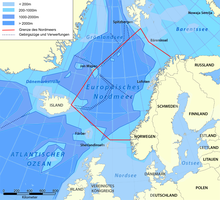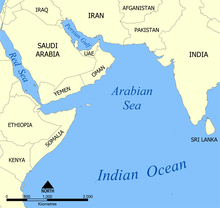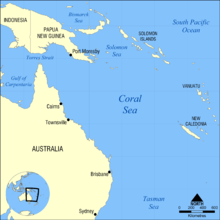List of seas on Earth


This is a list of seas of the World Ocean, including marginal seas, areas of water, various gulfs, bights, bays, and straits.[2] In many cases it is a matter of tradition for a body of water to be named a sea or a bay, etc., therefore all these types are listed here.
Terminology
[edit]- Ocean – the four to seven largest named bodies of water in the World Ocean, all of which have "Ocean" in the name .
- Sea has several definitions:[a]
- A division of an ocean, delineated by landforms,[6] currents (e.g., Sargasso Sea), or specific latitude or longitude boundaries. This includes but is not limited to marginal seas, and this is the definition used for inclusion in this list.
- A marginal sea is a division of an ocean, partially enclosed by islands, archipelagos, or peninsulas, adjacent to or widely open to the open ocean at the surface, and/or bounded by submarine ridges on the sea floor.[7]
- The World Ocean. For example, the Law of the Sea states that all of the World Ocean is "sea",[8][9][10][b] and this is also common usage for "the sea".
- Any large body of water with "Sea" in the name, including lakes.
- River – a narrow strip of water that flows over land from a higher elevation to a lower one
- Tributary – a small river that flows into a larger one
- Estuary – the piece of a river that flows into the sea or ocean
- Strait – a narrow area of water connecting two wider areas of water, also sometimes known as a passage
- Channel – usually wider than a strait
- Passage – connects waters between islands, also sometimes known as a strait
- Canal – a human-made channel
- Fjard – a large open water between groups of islands
There are several terms used for bulges of ocean that result from indentations of land, which overlap in definition, and which are not consistently differentiated:[12]
- Bay – generic term; though most features with "Bay" in the name are small, some are very large
- Gulf – a very large bay, often a top-level division of an ocean or sea
- Fjord – a long bay with steep sides, typically formed by a glacier
- Bight – a bay that is typically shallower than a sound
- Sound – a large, wide bay which is typically deeper than a bight, or a strait
- Cove – a small, typically sheltered bay with a relatively narrow entrance
- Inlet – a narrow and long bay similar to a land peninsula, but adjoining the sea
- Polynya – least used of these terms, a patch of water surrounded by ice
Many features could be considered to be more than one of these, and all of these terms are used in place names inconsistently; especially bays, gulfs, and bights, which can be very large or very small. This list includes large areas of water no matter the term used in the name.
Largest seas by area
[edit]The largest terrestrial seas, in decreasing order of area, are:
- Philippine Sea – 5.695 million km2 (2.199 million sq mi)
- Coral Sea – 4.791 million km2 (1.850 million sq mi)
- American Mediterranean Sea – 4.200 million km2 (1.622 million sq mi)
- Arabian Sea – 3.862 million km2 (1.491 million sq mi)
- Sargasso Sea – 3.5 million km2 (1.4 million sq mi)
- South China Sea – 3.5 million km2 (1.4 million sq mi)
- Weddell Sea – 2.8 million km2 (1.1 million sq mi)
- Caribbean Sea – 2.754 million km2 (1.063 million sq mi)
- Mediterranean Sea – 2.510 million km2 (0.969 million sq mi)
- Gulf of Guinea – 2.35 million km2 (0.91 million sq mi)
- Tasman Sea – 2.3 million km2 (0.89 million sq mi)
- Bay of Bengal – 2.172 million km2 (0.839 million sq mi)
- Bering Sea – 2 million km2 (0.77 million sq mi)
- Sea of Okhotsk – 1.583 million km2 (0.611 million sq mi)
- Gulf of Mexico – 1.550 million km2 (0.598 million sq mi)
- Gulf of Alaska – 1.533 million km2 (0.592 million sq mi)
- Barents Sea – 1.4 million km2 (0.54 million sq mi)
- Norwegian Sea – 1.383 million km2 (0.534 million sq mi)
- East China Sea – 1.249 million km2 (0.482 million sq mi)
- Hudson Bay – 1.23 million km2 (0.47 million sq mi)
- Greenland Sea – 1.205 million km2 (0.465 million sq mi)
- Somov Sea – 1.15 million km2 (0.44 million sq mi)
- Mar de Grau – 1.14 million km2 (0.44 million sq mi)
- Riiser-Larsen Sea – 1.138 million km2 (0.439 million sq mi)
- Sea of Japan – 1.05 million km2 (0.41 million sq mi)
- Argentine Sea – 1 million km2 (0.39 million sq mi)
- East Siberian Sea – 987,000 km2 (381,000 sq mi)
- Lazarev Sea – 929,000 km2 (359,000 sq mi)
- Kara Sea – 926,000 km2 (358,000 sq mi)
- Scotia Sea – 900,000 km2 (350,000 sq mi)
- Labrador Sea – 841,000 km2 (325,000 sq mi)
- Andaman Sea – 797,700 km2 (308,000 sq mi)
- Laccadive Sea – 786,000 km2 (303,000 sq mi)
- Irminger Sea – 780,000 km2 (300,000 sq mi)
- Solomon Sea – 720,000 km2 (280,000 sq mi)
- Mozambique Channel – 700,000 km2 (270,000 sq mi)
- Cosmonauts Sea – 699,000 km2 (270,000 sq mi)
- Banda Sea – 695,000 km2 (268,000 sq mi)
- Baffin Bay – 689,000 km2 (266,000 sq mi)
- Laptev Sea – 662,000 km2 (256,000 sq mi)
- Arafura Sea – 650,000 km2 (250,000 sq mi)
- Ross Sea – 637,000 km2 (246,000 sq mi)
- Chukchi Sea – 620,000 km2 (240,000 sq mi)
- Timor Sea – 610,000 km2 (240,000 sq mi)
- North Sea – 575,000 km2 (222,000 sq mi)
- Bellingshausen Sea – 487,000 km2 (188,000 sq mi)
- Beaufort Sea – 476,000 km2 (184,000 sq mi)
- Red Sea – 438,000 km2 (169,000 sq mi)
- Black Sea – 436,000 km2 (168,000 sq mi)
- Gulf of Aden – 410,000 km2 (160,000 sq mi)
- Yellow Sea – 380,000 km2 (150,000 sq mi)
- Baltic Sea – 377,000 km2 (146,000 sq mi)
- Caspian Sea – 371,000 km2 (143,000 sq mi)
- Libyan Sea – 350,000 km2 (140,000 sq mi)
- Mawson Sea – 333,000 km2 (129,000 sq mi)
- Levantine Sea – 320,000 km2 (120,000 sq mi)
- Java Sea – 320,000 km2 (120,000 sq mi)
- Gulf of Thailand – 320,000 km2 (120,000 sq mi)
- Celtic Sea – 300,000 km2 (120,000 sq mi)
- Gulf of Carpentaria – 300,000 km2 (120,000 sq mi)
- Celebes Sea – 280,000 km2 (110,000 sq mi)
- Tyrrhenian Sea – 275,000 km2 (106,000 sq mi)
- Sulu Sea – 260,000 km2 (100,000 sq mi)
- Cooperation Sea – 258,000 km2 (100,000 sq mi)
- Persian Gulf – 251,000 km2 (97,000 sq mi)
- Flores Sea – 240,000 km2 (93,000 sq mi)
- Gulf of St. Lawrence – 226,000 km2 (87,000 sq mi)
- Bay of Biscay – 223,000 km2 (86,000 sq mi)
- Aegean Sea – 214,000 km2 (83,000 sq mi)
- Gulf of Anadyr – 200,000 km2 (77,000 sq mi)
- Molucca Sea – 200,000 km2 (77,000 sq mi)
- Oman Sea – 181,000 km2 (70,000 sq mi)
- Ionian Sea – 169,000 km2 (65,000 sq mi)
- Gulf of California – 160,000 km2 (62,000 sq mi)
- Balearic Sea – 150,000 km2 (58,000 sq mi)
- Adriatic Sea – 138,000 km2 (53,000 sq mi)
Marginal seas by ocean
[edit]Seas may be considered marginal between ocean and land, or between oceans in which case they may be treated as marginal parts of either. There is no single ultimate authority on the matter.[13]
Arctic Ocean
[edit](clockwise from 180°)
- Chukchi Sea
- East Siberian Sea
- Laptev Sea
- Kara Sea
- Barents Sea (connected to the Kara Sea by the Kara Strait)
- Queen Victoria Sea
- Wandel Sea
- Greenland Sea
- Lincoln Sea (recognized by the IHO but not the IMO)
- Baffin Bay
- The Northwest Passages
- Hudson Bay
- Beaufort Sea
Atlantic Ocean
[edit]In addition to the marginal seas listed in the three subsections below, the Arctic Ocean itself is sometimes also considered a marginal sea of the Atlantic.[14][15]
Africa and Eurasia
[edit]

- Norwegian Sea
- North Sea
- Baltic Sea
- English Channel
- Irish Sea
- Celtic Sea
- Bay of Biscay
- Gulf of Cádiz
- Mediterranean Sea
- Black Sea[16]
- Bay of Arguin
- Yawri Bay
- Gulf of Guinea
- Luanda Bay
- Walvis Bay
- Saldanha Bay
- Table Bay
- False Bay
Americas
[edit](coast-wise from north to south)
- North Water Polynya
- Baffin Bay
- Davis Strait
- Home Bay
- Labrador Sea
- Gulf of St. Lawrence
- Gulf of Maine
- Nantucket Sound
- Vineyard Sound
- Buzzards Bay
- Narragansett Bay
- Rhode Island Sound
- Block Island Sound
- Fishers Island Sound
- Long Island Sound
- Shelter Island Sound
- Noyack Bay
- Peconic Bay
- Gardiners Bay
- Tobaccolot Bay
- Sag Harbor Bay
- Three Mile Harbor
- Long Beach Bay
- Pipes Cove
- Southold Bay
- Flanders Bay
- Napeague Bay
- Fort Pond Bay
- North Sea Harbor
- New York Bay
- Jamaica Bay
- Raritan Bay
- Sandy Hook Bay
- Delaware Bay
- Chesapeake Bay
- Albemarle Sound
- Pamlico Sound
- American Mediterranean Sea
- Bay of All Saints
- Guanabara Bay
- Lagoa dos Patos
- Argentine Sea
Northern islands
[edit]
(from east to west)
- Irish Sea (between Great Britain and Ireland)
- Inner Seas off the West Coast of Scotland
- Sea of the Hebrides (Great Britain)
- Denmark Strait (between Greenland and Iceland)
- Irminger Sea
Indian Ocean
[edit]
- Andaman Sea
- Gulf of Martaban – an arm of the Andaman Sea in the southern part of Myanmar
- Arabian Sea
- Bay of Bengal
- Gulf of Aden
- Gulf of Oman
- Laccadive Sea
- Mozambique Channel
- Persian Gulf
- Red Sea
- Sea of Zanj
- Timor Sea
- Palk Strait
- Palk Bay
- Gulf of Mannar
Pacific Ocean
[edit]
Americas
[edit]- Bering Sea
- Chilean Sea
- Gulf of Alaska
- Salish Sea
- Gulf of California (also known as the Sea of Cortés)
- Gulf of the Farallones
- Gulf of Fonseca
- Gulf of Guayaquil
- Gulf of Nicoya
- Gulf of Panama
- Grau Sea
- San Francisco Bay
Australia and Eurasia
[edit]- Arafura Sea
- Bali Sea
- Banda Sea
- Bay of Kampong Som
- Bay of Plenty
- Bismarck Sea
- Bohai Sea
- Bohol Sea (also known as the Mindanao Sea)
- Camotes Sea
- Celebes Sea
- Ceram Sea
- Coral Sea
- Devil's/Dragon's Sea
- East China Sea
- Flores Sea
- Gulf of Carpentaria
- Gulf of Thailand
- Halmahera Sea
- Hauraki Gulf
- Hawke's Bay
- Java Sea
- Koro Sea
- Molucca Sea
- Philippine Sea
- Poverty Bay
- Sagami Bay
- Savu Sea
- Sea of Japan
- Sea of Okhotsk
- Seto Inland Sea
- Sibuyan Sea
- Solomon Sea
- South China Sea
- South Seas
- Sulu Sea
- Tasman Sea
- Tokyo Bay
- Visayan Sea
- Waihau Bay
- Yellow Sea
Southern Ocean
[edit]- Amundsen Sea
- Bellingshausen Sea
- Cooperation Sea[c]
- Cosmonauts Sea[c]
- Davis Sea
- D'Urville Sea
- Drake Passage
- King Haakon VII Sea[c]
- Lazarev Sea[c]
- Mawson Sea[c]
- McMurdo Sound
- Polynyas in McMurdo Sound
- Riiser-Larsen Sea
- Ross Sea
- Scotia Sea
- Somov Sea[c]
- Spencer Gulf
- Weddell Sea
- Weddell Polynya/Maud Rise Polynya
Defined by ocean currents
[edit]While all other seas in the world are defined at least in part by land boundaries, there is only one sea which is defined only by ocean currents:[20]
- Sargasso Sea – a sea defined by the four ocean currents which create the North Atlantic Gyre
Not included
[edit]Entities called "seas" which are not divisions of the World Ocean are not included in this list. Excluded are:
- Lakes, ponds, etc.:
- Salt lakes with "Sea" in the name: Aral Sea, Dead Sea, Salton Sea
- Freshwater lakes with "Sea" in the name: Sea of Galilee
- Bodies of water identified in lakes (bays, straits, etc.)
- Ocean gyres
- Seas in fiction, religion or mythology
See also
[edit]- Inland sea (geology)
- Mediterranean sea (oceanography)
- Oceanography
- List of largest lakes and seas in the Solar System
Notes
[edit]- ^ There is no accepted technical definition of sea among oceanographers. A rather weak definition is that a sea is a subdivision of an ocean, which means that it must have oceanic basin crust on its floor. This definition, for example, accepts the Caspian Sea, which was once part of an ancient ocean, as a sea.[3] The Introduction to Marine Biology defines a sea as a "landlocked" body of water, adding that the term "sea" is only one of convenience, but the book is written by marine biologists, not oceanographers.[4] The Glossary of Mapping Sciences similarly states that the boundaries between seas and other bodies of water are arbitrary.[5]
- ^ According to this definition, the Caspian would be excluded as it is legally an "international lake".[11]
- ^ a b c d e f Proposed names to the IHO 2002 draft. This draft was never approved by the IHO (or any other organization), and the 1953 IHO document (which does not contain these names which mostly originated from 1962 onward) remains currently in force.[17] Leading geographic authorities and atlases do not use these names, including the 2014 10th edition World Atlas from the National Geographic Society and the 2014 12th edition of the Times Atlas of the World. But Soviet and Russian-issued state maps do include them.[18][19]
References
[edit]- ^ INTERNATIONAL HYDROGRAPHIC ORGANIZATION – LIMITS OF OCEANS AND SEAS
- ^ OCEANS & SEAS OF THE WORLD
- ^ Conforti, B; Bravo, Luigi Ferrari (2005). The Italian Yearbook of International Law 2004. Martinus Nijhoff Publishers. ISBN 9789004150270.
- ^ Karleskint, George; Turner, Richard L; Small, James W (2009). Introduction to Marine Biology. Cengage Learning. ISBN 9780495561972.
- ^ The Glossary of the Mapping Sciences – Google Books. ASCE Publications. 1994. ISBN 9780784475706. Retrieved 2013-04-19.
- ^ "What's the difference between an ocean and a sea?". Oceanservice.noaa.gov. 11 January 2013. Retrieved 19 April 2013.
- ^ American Congress on Surveying and Mapping (1994). Glossary of the mapping sciences. ASCE Publications. p. 469. ISBN 978-0-7844-0050-0. Retrieved 9 December 2010.
- ^ Vukas, B (2004). The Law of the Sea: Selected Writings. Martinus Nijhoff Publishers. ISBN 9789004138636.
- ^ Gupta, Manoj (2010). Indian Ocean Region: Maritime Regimes for Regional Cooperation. Springer. ISBN 9781441959898.
- ^ "Discover The Seven Seas of the Earth". Geography.about.com. Retrieved 2013-04-19.
- ^ Gokay, Bulent (2001). The Politics of Caspian Oil. Palgrave Macmillan. ISBN 9780333739730.
- ^ "gulf – coastal feature".
- ^ Wang, James C. F. (1992). Handbook on Ocean Politics & Law. Greenwood Publishing Group. p. 14. ISBN 978-0-313-26434-4.
- ^ James C. F. Wang (1992). Handbook on ocean politics & law. Greenwood Publishing Group. pp. 14–. ISBN 9780313264344. Retrieved 9 December 2010.
- ^ Longhurst, Alan R. (2007). Ecological Geography of the Sea. Academic Press. p. 104. ISBN 978-0-12-455521-1.
- ^ a b c d e f g h i Often treated as a part of the Mediterranean Sea.
- ^ "Limits of Oceans and Seas, 3rd (currently in-force) edition" (PDF). International Hydrographic Organization. 1953. Archived from the original (PDF) on 8 October 2011. Retrieved 28 December 2020.
- ^ Антарктида, rubricon.com/ (map)
- ^ "Антарктида". gturs.com. Archived from the original on 2015-09-10. Retrieved 2015-06-06. (map)
- ^ National Oceanic and Atmospheric Administration – What is the Sargasso Sea?
External links
[edit] The dictionary definition of marginal sea at Wiktionary
The dictionary definition of marginal sea at Wiktionary

